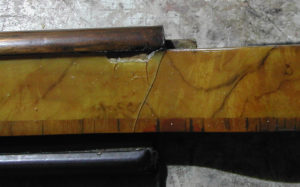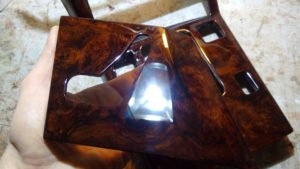The glues
In really old cars, it is possible to find traces of animal glues, but these were very soon replaced by the “uf” glues. Placed on the market in the ‘20s, these are composed of formaldehyde and urea and form an extremely strong and rigid bond with the wood; above all, they are very stable at temperature changes. In addition, these glues do not soften with the increase of temperature and form in a few minutes an effective bonding at high temperature; the cost is relatively cheap.
For these reasons, they represent the choice of all manufacturers to assemble the wood veneers to the base.
However, this family of glues, shall be destroyed by humidity and water. A lot of delaminated plywoods or veneers detached are the result of these aggressions.
I prefer to use other type of glues, more flexible than “uf” but resistant to water and humidity.
 Wood part under the windscreen of a Mercedes W108. The delamination is caused by the infiltration of water and moisture from the windshield seal and the result is the completely destruction of formaldehyde glue.
Wood part under the windscreen of a Mercedes W108. The delamination is caused by the infiltration of water and moisture from the windshield seal and the result is the completely destruction of formaldehyde glue.
The finish
Alkyd paints: for the very first fabricated cars, it is common to find alkyd paint, composed of ester oil.
Nitrocellulose: the first paints were very quickly replaced by nitrocellulose paints, which have the peculiarity to be sprayed in consecutive thin coats without intermediate sanding. Each coat applied, melts the underneath and chemically binds into a one whole. The dry-to-touch-time is immediate; however a deeply dry time is very long (and consequently the process of sanding) and it can take even six months. These type of paints suffered by UV rays and the rapid temperatures changes. As time goes by, they also crystallize and lose flexibility so a lot a micro-craks show up (crow’s feet effect).
 The micro-cracks are difficult to detect. The ageing of nitrocellulose manifests itself in a web of micro-cracks (known as crow’s feet effect).
The micro-cracks are difficult to detect. The ageing of nitrocellulose manifests itself in a web of micro-cracks (known as crow’s feet effect).
Polyester: In the ‘70s, with the rationalization of production and the increasing cars built for each model, the manufacturers organized themselves to produce valuable woodworks at a lower cost than before. This moment coincides with the advent of Mercedes-Benz W114 and R107, with the Silver Shadow and Rolls Royce/Bentley T, with the XJ Third Series of Jaguar. The polyester resin is used to impregnate the glass fibre for obtaining fibreglass. These are catalyzed products with a very quick and deep drying time. It is possible to lay down a lot of resin in layers (thickness calculated in millimetres) in a few hands. The advantage would be a block-sanding and a polishing without the risk of wearing out the finishing. The costs are reasonably small. The polyester resins are rather polluting and can emit harmful substances (styrene) for months. They are sensitive to UV rays, turn yellow with age and lose transparency, by helping to create the typical ‘fake wood’ effect. Being an extremely thick and rigid films, they often cannot follow the natural wood’s movement creating big cracks. These resins play a crucial part in wood veneers oxidation and don’t act as a barrier to humidity. Unfortunately, some of these veneers painted with these resins cannot be saved, and need to be replaced. By the same philosophy, polyester resins may be used to impregnate the tissue with carbon or, in their turn, tissue with black polyester (fake carbon). This kind of carbon articles is bound to have a short useful life and can only be conceived as very cheap furniture finishing (even if in a lot of commercial advertising are presented as derivatives of Formula 1). They are fated to crack due to their vitreous consistence and above all, they can’t be repaired. Any carbon insert should be composed of carbon tissue and epoxy resins.

Clearly visible effects of polyester resins: cracks, loss of transparency and oxidation.
My proposal is essentially based on an exclusive finishing cycle for resolving successfully the problems listed above and is essentially based on three products with epoxide and copolymers matrix:
- epoxy resins with high resistant to UV rays and therefore without turning yellow
- loss of transparency next to nothing
- pollutants emissions practically just about zero during the entire useful life of the final product
- substantial reduction of material employed
- created a protective barrier against humidity and water
- even if it is a film pretty rigid, retains an intrinsic flexibility for following the woods movements without crack
- mirror finish polishing with a considerable transparency and high gloss
On the opposite side, these resins are less resistant to scratches than polyesters, must be applied in several thin coats, need stable temperature and humidity during processing, post curing in oven after application and last but not least, required a considerable amount of skill in sanding and polishing for a highly standard and a high price.

Epoxy finish, characterized by a complete transparency and brilliance without the plastic-wood effect.
Wood veneers
For all cars are used thin sheets of wood, glued to a stronger and resistant base as solid wood, plywood, metal and in our case…also in carbon fibre!
Veneer was born in the 19th century, with the expansion of huge machinery for producing veneers that conceptually, can be compared to slicing machines. Practically, the trunk of the tree is sliced, and the slices are the veneer sheets. Today there are a lot of specialized companies in slicing and marketing of these specific products, well-ordered and catalogued by type of wood and quality level. Indeed, there are trunks of the same species with high-value drawings than others, with a consequent aesthetic and price difference.
We must naturally take in consideration the fact that the trees of a same wood species may produce trunks very different from each other, as Walnut burls and Rosewood. Therefore, apart the effects due to sun exposure and environmental factors, it is not by chance that there are clear aesthetic difference between the Walnut burl of a Mercedes-Benz W111 Coupè and a SL R107. The same could be said for a Bentley S and a Jaguar XJ 3rd generation sedan The manufacturers have made specific choices at the time of ordering veneers from their providers.
For Mercedes-Benz W111/112 and Rolls-Royce Silver Cloud have been used veneers of exceptional quality; for W107 or the XJ 3rd series the quality was significantly lower, often hidden by wood coatings that standardized the natural differences as the grain pattern of wood.
For a high level restore it is very important to use the correct type and quality of veneer. Very often this parameters are not even considered: it is not difficult to see a Mercedes-Benz 280 SE convertible re-veneered with the typical walnut veneer used in the XJ 3rd series six-cylinder.
Fake wood or RECONSTRUCTED WOOD: we note, with some bitterness, that some manufactures still using reconstruct wood instead of real wood. It is clearly visible, for example, in some BMW X6. Commonly, this type of material is called fineline wood, Sarifo and so on.
But what exactly is reconstructed wood? Contrary to natural veneer, obtained from a trunk sliced in thin precious sheets, the reconstructed wood is constituted by gluing together various types of second-rate and coloured sheets of wood (usually poplar or toulipier). In this way are realized huge boards whose thickness is characterized by the alternation of light and dark sheets, that simulate the grain of the natural wood. Sawing these boards, the veneers of reconstructed wood are obtained; they’re cheaper than the real wood veneers. The problem is that it is definitely not difficult to come across restorations based on reconstructed wood instead of real wood. At first sight is a nice appearance, but there are no comparison with the real wood.

Natural genuine Makassar Ebony veneer, refinished in epoxy. Background: fake wood finished in polyester.
My working philosophy, brings me to not use reconstructed wood but go to veneers suppliers personally for selecting every single veneer that will be used. Some varieties and species are getting difficult to find, such as European walnut-root or the protected species of Brazilian rosewood. In fact, for the last one, it is possible to use only unsold stock.

